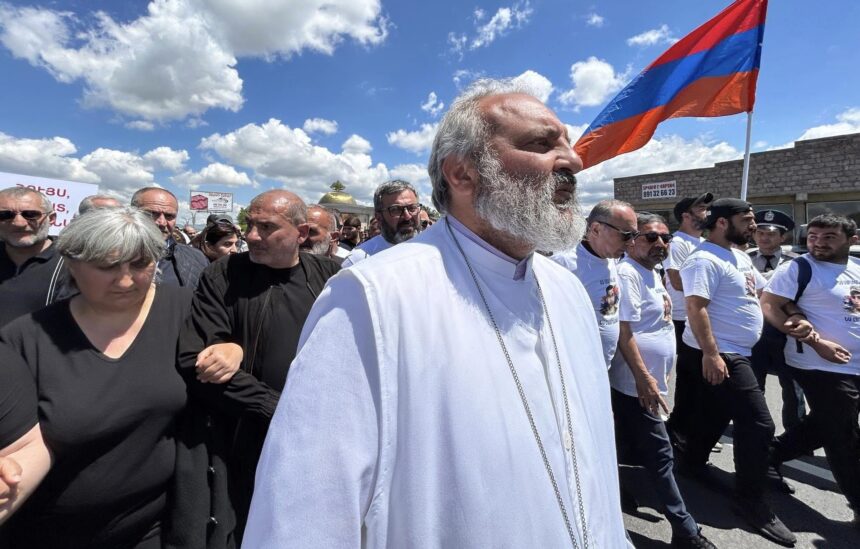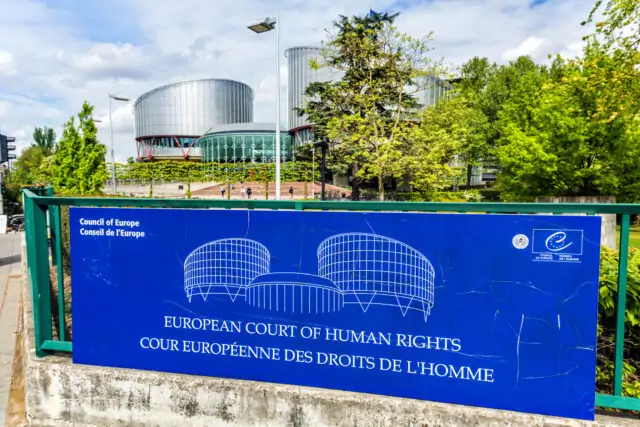
Clergy-Led Demonstrations Raise Concerns Over Separation of Church and State in Armenia
Clergy-Led Demonstrations Raise Concerns Over Separation of Church and State in Armenia
Executive Summary:
- Thousands of protestors demand an end to the delimitation and demarcation of the Gazakh–Tavush border between Armenia and Azerbaijan while pushing to remove Armenian Prime Minister Nikol Pashinyan from power.
- An Archbishop of the Armenian Apostolic Church is leading these protests, raising questions about the separation of Church and State in the former Soviet republic.
- The protests demonstrate how potentially vulnerable Pashinyan is to any opposition led by relatively unknown figures, such as the Archbishop, untainted by any obvious links to deeply unpopular previous governments, as the 2026 parliamentary elections approach.
On May 9, thousands of Armenians gathered in Yerevan’s Republic Square to protest the return of four villages de jure part of Azerbaijan but de facto under the control of Armenia since the early 1990s (see EDM, April 8). According to the Union of Informed Citizens, the crowd contained around 31,700 people (UIC, May 9). It was the largest protest in Armenia since Armenian Prime Minister Nikol Pashinyan rose to power in 2018. This time, however, the demonstration was led not by the political opposition but by Archbishop Bagrat Galstanyan, a prominent cleric in the Armenian Apostolic Church. Other senior clergy have also joined (News.am, May 8).
The Armenian Apostolic Church, despite being recognized in the constitution as having the “exclusive mission … in the spiritual life of the Armenian people,” had stayed away from politics. Under Pashinyan’s six years in office, however, a schism has emerged between the Church and government. “A process is being generated to carry out a coup in Armenia in an undemocratic way. … The church is fully engaged in this,” one ruling party member of parliament stated this month (Azatutyun, May 10). A senior member of Pashinyan’s Civil Contract party has gone further, accusing Moscow of being behind the alleged coup (Haykakan Zhamanak, May 7). More recently, Foreign Minister Ararat Mirzoyan accused those against demarcation of undermining the “sovereignty, statehood, and territorial integrity of the Republic of Armenia,” at the “dictation of another country,” a thinly veiled reference, most likely, to Russia (Azatutyun, May 13). There remains, however, a lack of evidence to support such allegations.
Galstanyan, who had for several weeks been leading small acts of civil disobedience in villages close to the Armenia–Azerbaijan border where demarcation has been taking place, issued a one-hour ultimatum for Pashinyan to resign. When he did not, the cleric met with the two opposition parliamentary factions led by former presidents Robert Kocharyan and Serzh Sargsyan for consultations. A second rally the next day attracted only 11,700 people (UIC, May 10). The crowd was even smaller two days later, but despite the drop in numbers still highlighted Pashinyan’s vulnerability as his opponents accuse him of defeatism and making unilateral concessions.
These events have also raised questions over the separation of Church and State. Pashinyan had already warned that the church should stay out of politics. In a live televised interview earlier the same week, he said, “A cleric cannot say a political text without the permission or instructions of the Catholicos of All Armenians [the head of the Armenian Apostolic Church, Karekin II]. … It is obvious that the leader of the [demonstrations] is the Catholicos of All Armenians, and the beneficiary is [former president] Robert Kocharyan.” Despite the real concerns, that is a far cry from last year when Pashinyan instead urged the church to do just that. “If the church wants to carry out political activities, Armenia is a democratic country, [and] it is possible. … Nothing prevents … creating a party and developing political activities,” he said (News Armenia, March 20, 2023).
For some Armenians, the Catholicos is considered one of the last remnants of the former regime —by association, links with Russia. In late 2022, Russian President Vladimir Putin awarded Karekin II a medal of honor for developing cultural relations between the two countries (News.am, November 11, 2022). The current spat, however, goes back a lot further. When Pashinyan came to power, others attempted to expand his party’s rebuttal of the old regime by launching another campaign, “New Armenia, New Patriarch,” to oust Karekin II (Eurasianet, July 20, 2018).
The two largely co-existed until Karekin II lobbied for Kocharyan’s release from prison, under detention for his alleged role in the March 1, 2008 state of emergency that left 10 people dead. Pashinyan accused the church of being responsible for the “lack of a spiritual life in Armenia” (Eurasianet, April 23, 2020). Another archbishop, Navasard Kchoyan, was also charged with fraud and money laundering, which some consider a related development (Azatutyun, April 16, 2020). Such revelations are not new. The Catholicos, Galstanyan, and other clergy have long been accused of corruption and fraud (Hetq, February 15, 2016; Civic.am, May 11).
Following Armenia’s defeat in the 44-day war with Azerbaijan in November 2020, however, the Catholicos raised the stakes by demanding Pashinyan’s resignation (Azatutyun, December 8, 2020). Karekin II had also convened a meeting of the three former presidents of Armenia, Ter-Petrosyan, Kocharyan, and Sargsyan, as well as the former de facto leaders of Karabakh, Arkhady Ghukasyan and Bako Sahakyan (Armenian Public Radio, September 22, 2022). This was seen as a joint effort to respond to Pashinyan’s failure to repel Azerbaijan’s incursion.
In April 2023, the Catholicos again called on Pashinyan to resign (Caucasus Watch, April 22, 2023). The following month, Pashinyan suggested that tax exemption for the import of paraffin to make candles by the church would be revoked. He implied that the Church was acting outside the framework of the constitution (Panorama, May 20, 2023). Pashinyan also launched into a pseudo-theological argument with Armenia’s religious leader. “If the church’s relations with the government are bad, then the church’s relations with God are bad,” he said. By June last year, those relations had dropped to even lower levels.
“Currently, there is no relationship between the church and the government,” Archbishop Galstanyan, the same cleric leading the demonstrations now, told the media. “For the church, the approach of the authorities to resolving the conflict, which boils down to recognizing Artsakh [Karabakh] as part of Azerbaijan, is unacceptable” (Eurasianet, June 30, 2023).
Galstanyan claims he is apolitical, and the protests are not against the demarcation process, only about how it is being implemented. Recent history, however, suggests otherwise. In April 2022, he was one of the priests who joined the nationalist Armenian Revolutionary Dashnaktsutyun-led protests calling for Pashinyan’s resignation and against normalizing relations with Baku. In December 2023, he identified as a “revanchist” and openly called for “revenge” to regain territory handed back to Azerbaijan (ABC Media, December 23, 2023). In March, he urged villagers not to cooperate with the demarcation commission and was frequently seen with several militant figures. These included Hampig Sassounian, who had been sentenced to life imprisonment for the assassination of the Turkish Consul General in Los Angeles in 1982 before his controversial parole in 2021 (Aravot, April 29).
In 2022, Kocharyan had also said he favored appointing a cleric as president of the country (ArmenPress, February 17, 2022). On the first day of the protests this year, former Foreign Minister Vartan Oskanyan, believed that Galstanyan would make an acceptable candidate for prime minister. The Archbishop, however, is a dual Armenian–Canadian national and is therefore ineligible to run (FIP, May 10, 2024). Even so, Galstanyan did not rule it out (Azatutyun; Radio Free Europe/Radio Liberty, May 12). “If the people want [it], and the Armenian Patriarch will bless [it], who am I to say no?” he said (News.am, May 10).
For now, with the protests failing to gain momentum, Pashinyan seems able to ride out the discontent. The emergence of Galstanyan and his attempt to bring down his premiership demonstrates how fragile the situation could become as parliamentary elections scheduled for 2026 draw closer. It should be noted that Galstanyan demonstrated the ability to unite a usually disparate assortment of historically fractious opposition forces—a useful skill if he intends to force out or replace Pashinyan .
However the standoff develops, the lines in the sand have been drawn not only between Yerevan and Etchmiadzin, the seat of the Armenian Apostolic Church, but also between what Pashinyan has termed a Historical Armenia, synonymous with previous governments and hardline elements in the diaspora, and his vision of a Real Armenia that looks to the future (Hetq, April 10; National Interest, May 11).


